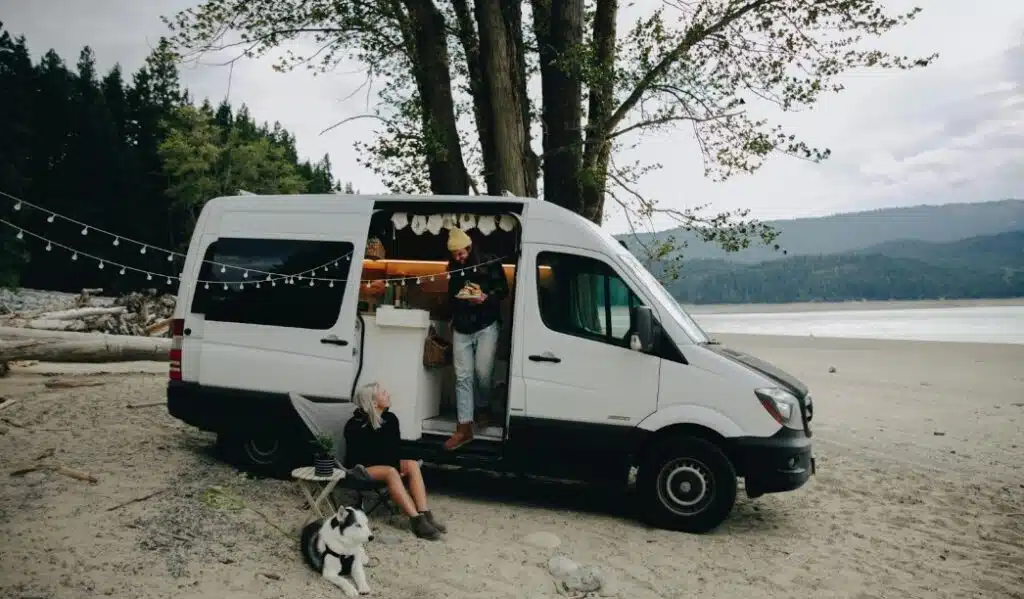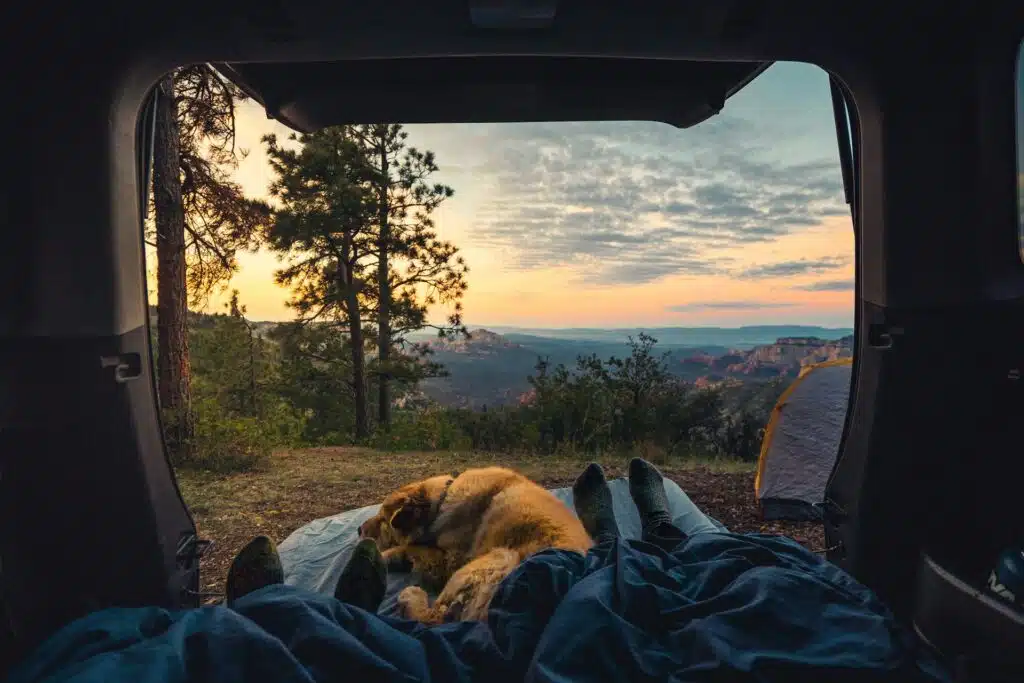There’s something different about swapping city noise for birdsong and damp gum leaves underfoot. And if your dog’s tail starts wagging the moment you pick up the car keys, then you already know—they were made for this. Dogs thrive under wide skies and open air. They often love to sniff out the magic in every dirt trail and creek crossing.
Bringing your four-legged furbaby along for a weekend in the bush can turn a simple getaway into something that sticks with you. But before you load up the car and head for the hills, you’ll want to get your ducks in a row. A bit of forethought now means you won’t be patching up problems later—because camping with a dog is fun, but it works best with a solid plan.
Let’s start with what you’ll need to sort before you even think about venturing into the great outdoors with your pooch.
Pre-Trip Checklist: Things to Sort Before You Go
Before you chuck a tennis ball in the back seat and call it a day, tick off a few key items. First things first—your dog needs to be traceable. That means a working microchip linked to your current phone number and a collar with ID tags that won’t rub off after the first romp through the bushes. If your dog gives chase to a kangaroo or trots off while you’re lighting the campfire, you want to know that someone can get them back to you.
Next up, make sure your pup’s got their health ducks in a row. That means vaccines are current, flea and tick preventatives are in play, and they’ve had a recent once-over from the vet.This is especially important if you’re travelling with a stud dog, as any outing brings exposure risks and it’s crucial to maintain top condition between matings. You don’t want your holiday ruined by a sudden limp, rash, or worse.
Now, where to go? Not every park or campsite is friendly to canine companions, so have a search around and pick a spot where dogs are welcome. Plenty of national parks are a hard no, but state forests, dog-friendly camping areas, hiking trails, and private campgrounds often welcome them with open arms—as long as you follow the rules.
And if your dog’s more used to the couch than the great outdoors, do a practice run. Try a backyard campout or even a single overnight in a quieter spot. You’ll both get a feel for what works—and what needs fixing—before you’re hours from home.
Essential Gear to Pack
Camping without the right supplies is asking for trouble—and that goes double when your best mate’s on four legs. You wouldn’t head out without your sleeping bag or torch, and your dog’s no different. They’ve got their own set of must-haves, and forgetting even one can throw a spanner in the works.
Start with the basics: a strong leash and a snug, well-fitting harness. Leave the retractable one at home. You’ll want steady control if your dog spots a goanna or gets a whiff of something wild in the wind. Add a collar with up-to-date tags—even if your dog’s chipped, you want that quick visual ID.
Water is a big one. Dogs don’t sweat, so they’ll overheat faster than you might think. Pack a collapsible bowl and more water than you reckon you’ll need. Streams and lakes might look clean, but all sorts of nasties can be hiding in there—better safe than stuck with a sick pup.
Food and treats are next on the list. Measure out each meal in advance, seal it in airtight containers, and don’t forget the snacks. Familiar food keeps tummies happy. Skip the temptation to feed leftovers from your campfire cook-up—dogs aren’t built for sausages and skewers.
Then there’s the stuff that keeps them comfy. Bring their usual bed or a thick sleeping mat that can handle dirt and dew. Dogs like a soft patch to rest, and a familiar scent can ease stress in new surroundings.
You’ll also need the cleanup kit: poop bags (plenty of them), a trowel if you’re wild camping, and a sealed bag or container for waste until you can bin it properly, since no one wants to come across any unwanted surprises.
Extras? Booties can protect paws from hot sand, sharp rocks, or spiky ground. A dog life jacket helps with lake swims, especially for smaller breeds or older dogs. A cooling vest can make hot afternoons more bearable. Tick remover tools are non-negotiable in certain areas—check the local risks before you go.
Safety Tips While Camping
So, you’ve found your patch of paradise, whether you’re joining Blue Mountain tours or you’ve found the most perfect secluded beach, what now? The tent’s up, marshmallows are roasting, and your dog’s already nose-deep in a tuft of grass. Time to relax, right? Sort of—but you’ve still got to keep a watchful eye on your pooch.
Rule number one: never let your dog roam off-leash unless you’re inside a fenced area or using a long lead tied to something solid. Even the best-behaved dog can dart after a squirrel or go sniffing into snake territory. Off-lead time sounds great, but you’re putting both your own pet at risk as well as local wildlife.
Speaking of the local wildlife, that’s another thing you should watch out for. Some animals won’t bother you unless provoked, but others won’t hesitate to defend their patch. Venomous snakes, nesting birds, and even some insects can turn a lazy afternoon into a trip to the emergency vet.
Stick to safe water, too. That bubbling creek might look clean enough to bottle, but hidden bacteria and parasites can cause stomach issues, which are never pleasant even at the best of times. Keep clean water available and discourage your dog from lapping up puddles or still water.
And at the end of each day, do a full-body scan. Check ears, paws, belly, and tail for ticks, burrs, cuts, or bites. Even tiny wounds can fester quickly in damp, dusty conditions. A quick once-over could save you from big trouble down the line.
Campsite Etiquette with Dogs
No one wants to be the reason another family packs up early. Just like noisy campers and midnight guitar strummers, poorly-behaved pets can put a damper on the whole bush experience. But with a little awareness, your dog can be the campsite favourite—not the reason for gritted teeth across the firepit.
First, think of others. Some folks love dogs. Others—not so much. Keep your pup close, either on a lead or inside a secure setup like a portable playpen or a shaded area beside your tent. Roaming dogs, no matter how friendly, can spook children or start trouble with other pets.
A little respect goes a long way. Treat the space like it’s yours—but shared. Ensure your pet is on their best behaviour and you’re sure to be the stars of the campground.
Conclusion
Spending time with our pets outdoors helps ground us in the moment, reminding us to pay attention to the now and forget the worries of the past and future.
But like any good trip, success hinges on what you bring, what you plan, and how well you read the situation as it unfolds. A happy, healthy dog makes for a relaxed and enjoyable getaway. An underprepared one? That can flip the mood in no time.
So, go on. Pack the leads. Load the kibble. Fill your boot with camping gear and your backseat with wagging tails. Choose your spot wisely, respect the land and the people who share it, and give your dog the kind of experience they can’t get from a daily walk around the block.



0 Comments